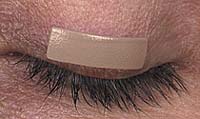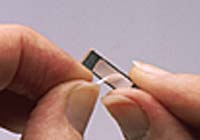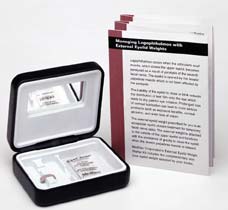Eyelid weights effective for ocular complications due to facial palsies
Eyelid weights for patients unable to close their eyes have been shown to be effective in combating corneal decompensation, visual acuity loss and a reliance on artificial tears.
|
|
|
|
Blinkeze External Lid Weights: The weights are attached to the upper eyelid using a double-sided, hypoallergenic EyeClose adhesive strip. |
Both external and implantable eyelid weights can be used to address ocular exposure associated with facial palsies and facial paralysis often caused by tumor, trauma, infection, surgery, ischemia and idiopathic Bell’s palsy. Based in Sunnyvale, Calif., MedDev Corp. has been providing implantable eyelid closure weights since 1969 and temporary external weights since 1995.
Richard Jobe, MD, one of the founders of MedDev and a former professor of plastic surgery at Stanford University, described one of his patients who did not want surgery. “The external eyelid weights help manage her permanent facial paralysis,” Dr. Jobe told Primary Care Optometry News.
External eyelid weights
Bell’s palsy patients who come to the optometrist’s office often have temporary facial palsies not requiring a permanent surgical implant of the weights. “A number of Bell’s palsy patients suffer for various lengths of time, and they would be really good candidates for this extra weight,” Dr. Jobe said.
Stuart R. Seiff, MD, professor of ophthalmology, University of California, San Francisco and director of ophthalmic plastic and reconstructive surgery, chief of ophthalmology, San Francisco General Hospital, agreed with Dr. Jobe that the external weights, which are prescription medical devices, are often used for temporary situations.
“Many researchers believe Bell’s palsy is the result of a viral infection affecting the facial nerve,” Dr. Seiff said in an interview. “The facial paralysis usually lasts only a few months, so we wouldn’t want to do a surgical procedure to deal with a temporary situation.”
Until recently, MedDev has been marketing almost exclusively to ophthalmic plastic surgeons who deal with facial paralysis, explained Dr. Jobe. The company has realized that because a number of patients benefit from the temporary use of eyelid weights and never need surgery, MedDev Corp. should look towards optometry as well.
Dr. Seiff explained, “Patients who are fitted with the external weights for temporary relief still need to be followed closely for corneal decompensation and may need surgical treatment as well if they decompensate.”
Attaching external weights
|
|
The external weights, developed by MedDev, are made of tantalum and are painted in a skin tone on the weight’s exposed side to enhance a patient’s appearance or approximate a patient’s complexion. The weights are attached to the upper eyelid using a double-sided, hypoallergenic EyeClose adhesive strip. The weights are supplied to patients with the tape so they can apply and reapply them at home. Patients are able to wear them for several days at a time before having to replace the tape.
“If it works, it works well. A patient can often leave the weights on for several days at a time,” Dr. Seiff said. Elderly patients without the dexterity to handle the tape sometimes present a challenge, he added.
As another option for such patients, Dr. Seiff has explored the possibility of using an isobutyl cyanoacrylate tissue adhesive with the weights. The glue can be used in the office as an off-label application, but it is not approved for individual sale with the weights for at-home patient use.
Loose upper eyelid skin may also make wearing the weights difficult for some patients, Dr. Seiff added.
In a study conducted by Dr. Seiff and colleagues (Seiff S, Boerner M, Carter S. Treatment of facial palsies with external eyelid weights. American Journal of Ophthalmology. 1995;120:652-657), the researchers concluded that in the treatment of ocular exposure associated with facial paralysis, the external weights decreased corneal exposure, decreased reliance on artificial tears and increased patient comfort. The weights were also helpful for some patients as a trial before implantation of eyelid weights as a longer-term treatment modality.
Internal eyelid weights
More than 30 years ago, Dr. Jobe developed a system of using different levels of internal eyelid weights to accommodate the various muscle strengths and patient conditions. The implanted weights, which are made of gold, are surgically positioned in the eyelid under a local anesthetic, he said. The procedure is also reversible.
Dr. Seiff is currently working on a study that shows that the implanted weights rarely extrude before 5 years. “Even when you look at patients out to 15 years, the extrusion rate is only about 30%,” he said. “Patients with the implanted weights have been able to greatly reduce the amount of artificial tears and ointments that they need in terms of maintaining comfort and the health of their corneas.”
For Your Information:
- Richard Jobe, MD, can be reached at (831) 438-4995; fax: (831) 438-1494; e-mail: rpjobe@stanford.edu.
- Stuart R. Seiff, MD, can be reached at 1001 Potrero Ave., Room 4M31, Box 0870, San Francisco, CA 94110-0870; (415) 353-2142; fax: (415) 206-6122.
- MedDev eyelid closure products are available from MedDev Corp., 730 North Pastoria Ave., Sunnyvale, CA 94085-3522; (408) 730-9702; fax: (408) 730-9732; www.meddev-corp.com.



